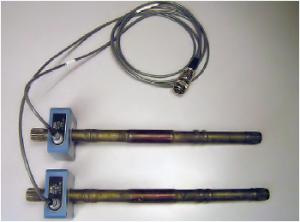Customer Problem
A transmission shaft manufacturer had a customer with three broken transmission shafts due to unacceptable case depth and wanted to implement NDT methods. The transmission shafts are manufactured from two different carbon steel alloys, 1045 and 5140. It was required to sort for acceptable case depth, 3.0 mm to 7.0 mm, within each material, as well as sort one material from the other. The manufacturer wanted to achieve a case depth separation of 0.1 mm.
The Solution
The manufacturer installed an eddy current test system to validate the case depth of the transmission shafts. The testing was successfully implemented using four pairs of External Reference Hardness coils (Figure 1). Using an external reference provides increased sensitivity verses using a self-reference coil.
Specifically, the manufacturer used an InSite HT-4 eddy current test instrument with four coils for reference and four for testing. This allowed them to perform in-line, simultaneous inspection at four positions along the transmission shaft. A data point at five different orientations from each good sample was used to build the part buffer and create the alarm limits for each of the four different test locations.
This eddy current test system allowed the manufacturer to achieve their goal of 0.1 mm case depth separation. External reference tests are very effective when inspecting bar-shaped products for proper case depth, alloy, or material structure hardness. As with any eddy current test, this test type can be successfully integrated within an automation system for use on a production line.



